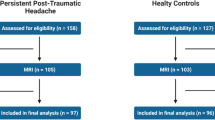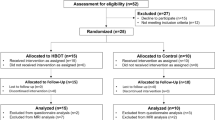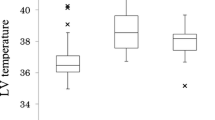Abstract
Concern is growing about the negative long-term effects of hyperbaric exposure on the central nervous system of divers. This study was conducted with magnetic resonance imaging (MRI) to evaluate attendants that work inside hyperbaric chambers (known as inside attendants) for hyperintense brain lesions. Ten inside attendants and 10 healthy nondiving subjects were included in the study. A questionnaire was used to obtain information about subjects’ medical history, hyperbaric exposure history, alcohol intake, and smoking habits. T1-weighted, T2-weighted, and fluid-attenuated inversion recovery images were acquired with a 1.5-T MRI device. A lesion was included in the count if it was hyperintense on both T2-weighted and fluid-attenuated inversion recovery images. Although MRI revealed 3 hyperintense brain lesions in 2 of 10 inside attendants and in none of the controls, the differences between groups were not statistically significant (P=.147). The number of brain lesions counted did not correlate with the age of the inside attendants (r=0.007;P=.978), the number of hyperbaric exposures (r=-0.203;P=.574), or the duration of work as an inside attendant (r=0.051; P=.890). Investigators found a correlation, however, between the number of cigarettes smoked in a day and the number of brain lesions identified (r=0.779;P < .01). An increased incidence of hyperintense brain lesions was not observed in inside attendants who had never experienced decompression sickness compared with nondiving controls. Additional multicenter epidemiologic studies are needed if the occupational safety of inside attendants is to be enhanced.
Similar content being viewed by others
References
Sheffield PJ, Pirone CJ. Decompression sickness in inside attendants. In: Workman WT, eds.Hyperbaric Facility Safety: A Practical Guide. Flagstaff, Ariz: Best Publishing Company; 1999: 643–663.
Thorsen E, Vaagbø G, Forland M, et al. Longitudinal follow up of lung function in personnel attending patients undergoing hyperbaric oxygen therapy [abstract]. Presented at: UHMS Annual Scientific Meeting; May 25–29,2004; Sydney, Australia. Available at: http://www.uhms.org/ AccAbsDBase/2004%20abs/N.htm.
Wilmshurst P. Brain damage in divers.BMJ. 1997; 314: 689–690.
Fueredi GA, Czarnecki DJ, Kindwall EP. MR findings in the brains of compressed-air tunnel workers: relationship to psychometric results.AJNR Am J Neuroradiol. 1991; 12: 67–70.
Reul J, Weis J, Jung A, Willmes K, Thron A. Central nervous system lesions and cervical disc herniations in amateur divers.Lancet. 1995; 345: 1403–1405.
Schwerzmann M, Seiler C, Lipp E, et al. Relation between directly detected patent foramen ovale and ischemic brain lesions in sport divers.Ann Intern Med. 2001; 134: 21–24.
Tetzlaff K, Friege L, Hutzelmann A, Reuter M, Holl D, Leplow B. Magnetic resonance signal abnormalities and neuropsychological deficits in elderly compressed-air divers.Eur Neurol. 1999; 42: 194–199.
Knauth M, Ries S, Pohimann S, et al. Cohort study of multiple brain lesions in sport divers: role of a patent foramen ovale.BMJ. 1997; 314: 701–705.
Eckenhoff RG, Olstad CS, Carrod G. Human dose-response relationship for decompression and endogenous bubble formation.J Appl Physiol. 1990; 69: 914–918.
Risberg J, Englund M, Aanderud L, Eftedal O, Flook V, Thorsen E. Venous gas embolism in chamber attendants after hyperbaric exposure.Undersea Hyperb Med. 2004; 31: 417–429.
Desautels DA. UHMS experience and mishap report (unpublished report). Associates/BNA Precourse on Chamber Safety, 1997 Undersea and Hyperbaric Medical Society Annual Scientific Meeting, Cancun, Mexico.
Hutzelmann A, Tetzlaff K, Reuter M, Muller-Hulsbeck S, Heller M. Does diving damage the brain? MR control study of divers’ central nervous system.Acta Radiol. 2000; 41: 18–21.
Rinck PA, Svihus R, de Francisco P. MR imaging of central nervous system in divers.J Magn Reson Imaging. 1991; 1: 293–299.
Sipinen SA, Ahovuo J, Halonen JP. Electroencephalography and magnetic resonance imaging after diving and decompression incidents: a controlled study.Undersea Hyperb Med. 1999; 26: 61–65.
Yanagawa Y, Okada Y, Terai C, et al. MR imaging of the central nervous system in divers.Aviat Space Environ Med. 1998; 69: 892–895.
Blogg SL, Loveman GA, Seddon FM, et al. Magnetic resonance imaging and neuropathology findings in the goat nervous system following hyperbaric exposures.Eur Neurol. 2004; 52: 18–28.
Author information
Authors and Affiliations
Rights and permissions
About this article
Cite this article
Ors, F., Sonmez, G., Yildiz, S. et al. Incidence of ischemic brain lesions in hyperbaric chamber inside attendants. Adv Therapy 23, 1009–1015 (2006). https://doi.org/10.1007/BF02850221
Issue Date:
DOI: https://doi.org/10.1007/BF02850221




